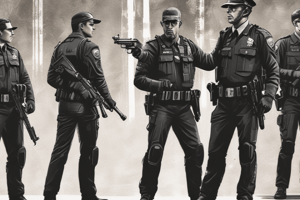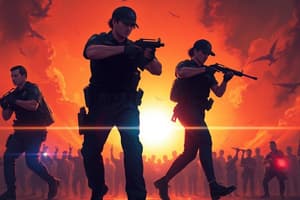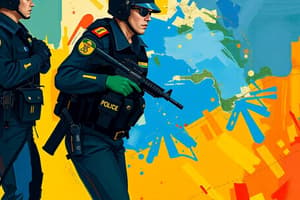Podcast
Questions and Answers
What is the primary intention behind using less-lethal force?
What is the primary intention behind using less-lethal force?
- To ensure long-term physical injury
- To incapacitate the subject permanently
- To demonstrate strength and authority
- To subdue or render a subject non-threatening (correct)
Which of the following is considered less-lethal weaponry?
Which of the following is considered less-lethal weaponry?
- Knives
- Machetes
- Firearms
- Pepper spray (correct)
What does 'necessary force' refer to in law enforcement?
What does 'necessary force' refer to in law enforcement?
- Force that is used as a last resort in all situations
- Force that exceeds necessary levels for an arrest
- Force sufficient to achieve a legitimate objective (correct)
- Force that is excessive and unjustified
The concept of 'objectively reasonable use of force' includes which of the following considerations?
The concept of 'objectively reasonable use of force' includes which of the following considerations?
Which statement accurately describes an unmanned aerial vehicle (UAV)?
Which statement accurately describes an unmanned aerial vehicle (UAV)?
What is NOT a component of command presence in law enforcement?
What is NOT a component of command presence in law enforcement?
Under what condition is a deputy justified in using force?
Under what condition is a deputy justified in using force?
Which of the following best describes a deputy's evaluation of their use of force?
Which of the following best describes a deputy's evaluation of their use of force?
When was the Bexar County Sheriff’s Office Use of Force Policy last revised?
When was the Bexar County Sheriff’s Office Use of Force Policy last revised?
What is the highest responsibility of all deputies of the Bexar County Sheriff’s Office as per the Use of Force Policy?
What is the highest responsibility of all deputies of the Bexar County Sheriff’s Office as per the Use of Force Policy?
Under what condition can an officer lawfully believe a warrant is valid?
Under what condition can an officer lawfully believe a warrant is valid?
What must an officer do before using force?
What must an officer do before using force?
According to the BCSO Use of Force policy, when is the use of force considered objectively reasonable?
According to the BCSO Use of Force policy, when is the use of force considered objectively reasonable?
When is it permissible to use objectively reasonable force?
When is it permissible to use objectively reasonable force?
What is the term used in the policy for any weapon approved for use by the BCSO?
What is the term used in the policy for any weapon approved for use by the BCSO?
What should deputies primarily do before resorting to force?
What should deputies primarily do before resorting to force?
Which of the following is considered deadly force, according to the policy?
Which of the following is considered deadly force, according to the policy?
When does the BCSO Use of Force policy permit the use of force in defense of a third person?
When does the BCSO Use of Force policy permit the use of force in defense of a third person?
When can a deputy use force to protect a third person?
When can a deputy use force to protect a third person?
What is emphasized in the use of force by deputies?
What is emphasized in the use of force by deputies?
What is the term used in the policy for any physical contact with a person by a deputy using the body or any object, device, or weapon, excluding un-resisted escorting or handcuffing?
What is the term used in the policy for any physical contact with a person by a deputy using the body or any object, device, or weapon, excluding un-resisted escorting or handcuffing?
What is an appropriate action if a subject complies after an initial use of force?
What is an appropriate action if a subject complies after an initial use of force?
How often is the BCSO Use of Force policy reevaluated?
How often is the BCSO Use of Force policy reevaluated?
What should deputies avoid doing in tense situations?
What should deputies avoid doing in tense situations?
Under what condition may a deputy use deadly force from a moving vehicle?
Under what condition may a deputy use deadly force from a moving vehicle?
In which scenario is it allowed to effect an arrest using deadly force?
In which scenario is it allowed to effect an arrest using deadly force?
What is the consequence of using the carotid neck hold according to the guidelines?
What is the consequence of using the carotid neck hold according to the guidelines?
What is required for using a flashlight as a weapon?
What is required for using a flashlight as a weapon?
When may a deputy use deadly force into buildings or places where offenders are hiding?
When may a deputy use deadly force into buildings or places where offenders are hiding?
What is the policy regarding the use of UAVs/UGVs with firearms?
What is the policy regarding the use of UAVs/UGVs with firearms?
What must be considered by a deputy when deciding to use deadly force based on circumstances?
What must be considered by a deputy when deciding to use deadly force based on circumstances?
What application of force is prohibited by the BCSO except in extreme circumstances?
What application of force is prohibited by the BCSO except in extreme circumstances?
Under what circumstances is a mounted patrol horse allowed to be used as a weapon?
Under what circumstances is a mounted patrol horse allowed to be used as a weapon?
Which condition is NOT applicable when handling riot situations?
Which condition is NOT applicable when handling riot situations?
What is the primary role of Mounted Patrol teams during a riot?
What is the primary role of Mounted Patrol teams during a riot?
What should be prioritized when using direct-fired impact projectiles during a riot?
What should be prioritized when using direct-fired impact projectiles during a riot?
Which of the following items may NOT be used by officers to control a riot?
Which of the following items may NOT be used by officers to control a riot?
In riot management, what is an appropriate use of bicycles?
In riot management, what is an appropriate use of bicycles?
When employing impact munitions like beanbags, what is the preferred targeting area?
When employing impact munitions like beanbags, what is the preferred targeting area?
What is necessary before weapons can be deployed during riot situations?
What is necessary before weapons can be deployed during riot situations?
Under what circumstances may devices be aimed at body center mass?
Under what circumstances may devices be aimed at body center mass?
What is the primary condition for using non-direct projectiles and munitions?
What is the primary condition for using non-direct projectiles and munitions?
What is required before deploying impact projectiles?
What is required before deploying impact projectiles?
In what situation are Electronic Control Weapons (ECWs) permitted to be used?
In what situation are Electronic Control Weapons (ECWs) permitted to be used?
Aerosol restraint spray can be used against which individuals?
Aerosol restraint spray can be used against which individuals?
What is the primary purpose of a baton in enforcement situations?
What is the primary purpose of a baton in enforcement situations?
Who is responsible for evaluating the need for the planned use of force?
Who is responsible for evaluating the need for the planned use of force?
Which procedure must be followed when utilizing force in correctional situations?
Which procedure must be followed when utilizing force in correctional situations?
Flashcards
Deadly Force
Deadly Force
Force intended or likely to cause death or serious injury.
Defense of Third Person
Defense of Third Person
Force that is used to protect a third person from immediate harm.
Firearm
Firearm
Any device that shoots projectiles using explosive power.
Force
Force
Signup and view all the flashcards
Objectively Reasonable Force
Objectively Reasonable Force
Signup and view all the flashcards
Approved Weapon
Approved Weapon
Signup and view all the flashcards
Deputies' Highest Responsibility
Deputies' Highest Responsibility
Signup and view all the flashcards
Purpose of Force Policy
Purpose of Force Policy
Signup and view all the flashcards
Less-lethal Force
Less-lethal Force
Signup and view all the flashcards
Less-lethal Weaponry
Less-lethal Weaponry
Signup and view all the flashcards
Necessary Force
Necessary Force
Signup and view all the flashcards
Objectively Reasonable Use of Force
Objectively Reasonable Use of Force
Signup and view all the flashcards
Command Presence
Command Presence
Signup and view all the flashcards
Unmanned Aerial Vehicle (UAV)
Unmanned Aerial Vehicle (UAV)
Signup and view all the flashcards
Unmanned Ground Vehicle (UGV)
Unmanned Ground Vehicle (UGV)
Signup and view all the flashcards
Justification for Use of Force
Justification for Use of Force
Signup and view all the flashcards
When are arrests/searches lawful?
When are arrests/searches lawful?
Signup and view all the flashcards
Officer identification during arrests/searches
Officer identification during arrests/searches
Signup and view all the flashcards
Verbal warning before force
Verbal warning before force
Signup and view all the flashcards
When is force objectively reasonable?
When is force objectively reasonable?
Signup and view all the flashcards
Force to protect a third person
Force to protect a third person
Signup and view all the flashcards
De-escalation techniques
De-escalation techniques
Signup and view all the flashcards
Measured, ascending use of force
Measured, ascending use of force
Signup and view all the flashcards
Prioritizing voluntary compliance
Prioritizing voluntary compliance
Signup and view all the flashcards
Use of force to stop a vehicle
Use of force to stop a vehicle
Signup and view all the flashcards
Force for arrest or escape prevention
Force for arrest or escape prevention
Signup and view all the flashcards
Force to enter buildings
Force to enter buildings
Signup and view all the flashcards
Force to protect a third party
Force to protect a third party
Signup and view all the flashcards
Carotid neck hold
Carotid neck hold
Signup and view all the flashcards
Using a flashlight as a weapon
Using a flashlight as a weapon
Signup and view all the flashcards
UAVs/UGVs and deadly force
UAVs/UGVs and deadly force
Signup and view all the flashcards
Mounted patrol horses and weapons
Mounted patrol horses and weapons
Signup and view all the flashcards
Mounted Patrol Horse as a Weapon
Mounted Patrol Horse as a Weapon
Signup and view all the flashcards
Force in Riot Situations
Force in Riot Situations
Signup and view all the flashcards
Weapon Deployment in Riots
Weapon Deployment in Riots
Signup and view all the flashcards
Canine Teams in Riots
Canine Teams in Riots
Signup and view all the flashcards
Mounted Patrol in Riots
Mounted Patrol in Riots
Signup and view all the flashcards
Bicycles in Riots
Bicycles in Riots
Signup and view all the flashcards
Impact Projectiles in Riots
Impact Projectiles in Riots
Signup and view all the flashcards
Impact Projectiles for Defense
Impact Projectiles for Defense
Signup and view all the flashcards
Impact Projectiles
Impact Projectiles
Signup and view all the flashcards
Non-direct (Skip-fired) Projectiles and Munitions
Non-direct (Skip-fired) Projectiles and Munitions
Signup and view all the flashcards
Electronic Control Weapons (ECWs)
Electronic Control Weapons (ECWs)
Signup and view all the flashcards
Aerosol Restraint Spray
Aerosol Restraint Spray
Signup and view all the flashcards
Baton or Similar Device
Baton or Similar Device
Signup and view all the flashcards
Reporting Use of Force in Crowd Situations
Reporting Use of Force in Crowd Situations
Signup and view all the flashcards
Use of Force in Detention Center
Use of Force in Detention Center
Signup and view all the flashcards
Planned Use of Force
Planned Use of Force
Signup and view all the flashcards
Study Notes
Bexar County Sheriff's Office Policy Manual - Use of Force
- The Bexar County Sheriff's Office prioritizes protecting human life and individual liberties.
- All force used in law enforcement must be objectively reasonable and proportionate to the circumstances.
- Deputies must use only the force a reasonably prudent officer would use in similar circumstances.
- The deputy's actions will be evaluated based on the information known at the time of force application.
9.03 Definitions
- Approved Weapon: Any weapon the BCSO approves.
- Deadly Force: Force intended or known to cause death or serious bodily injury.
- Defense of Third Person: Force to protect a third person from imminent harm.
- Firearm: A device designed to expel a projectile by explosion or burning substance.
- Force: Physical contact with a person using the body, object, or weapon—excluding unresisted escort or handcuffing.
- Less-Lethal Force: Force intending to subdue a subject without causing serious bodily harm..
- Less-Lethal Weaponry: Items like pepper spray, pepper balls, etc., less likely to cause death or serious injury.
9.04 Use of Force
- Force used in law enforcement must be objectively reasonable.
- Deputies apply force based on information presented at the time.
- Justification for force exists when a deputy believes force is immediately necessary for arrest, search, or preventing escapes.
- Officers must identify themselves and their lawful purpose before using force.
9.05 Use of Less-Lethal Force
- Less-lethal force is permissible when conventional methods are insufficient and immediate force is needed.
- Force options include strikes, kicks, and less-lethal weaponry, with careful consideration of potential harm.
9.06 Use of Deadly Force
- Deadly force is only justified if a reasonable officer believes it is necessary to prevent death or serious bodily harm.
- Deadly force against fleeing persons is limited to cases of imminent or substantial risk of injury or death.
- Using deadly force requires careful consideration of the situation.
9.07 Use of Force in Riot Situations
- Use of force in crowd control must be objective and proportional.
- Considerations: stopping violence, rescuing victims, and providing medical treatment.
9.08 Use of Force in Correctional Situations
- Medical assistance is required for anyone injured during or after a use of force situation.
- Use of Force must be based on policy and reasonable judgment.
9.09 Planned Use of Force (UOF)
- Planned UOF occurs when time allows for a realistic assessment.
- Factors include the number of staff, tactics, and restraints used.
- Planned situations may arise from violent threats, warrants, or incidents.
9.10 Medical Assistance
- Medical assistance is required for anyone (witness, bystander, arrestee) with visible injuries or injuries requiring attention.
9.11 Deadly Force Against Animals
- Deadly force against animals is only acceptable when protecting against injury or death to the deputy or others.
- Supervisory approval is necessary in certain circumstances.
9.12 Required Reports
- Any force-related incidents must be documented, including the rationale behind the use of force.
- This documentation involves a complete record of events, including the subject's actions, the cause, etc.
9.13 Investigations Required
- Use of force investigations follow the Sheriff's Office policies.
- Supervisors must be notified when any use of force takes place.
9.14 Notification to Sheriff
- Deputies must notify the proper authorities immediately if a firearm is discharged in any capacity.
- Supervisors and the Sheriff must be promptly notified, if applicable.
Studying That Suits You
Use AI to generate personalized quizzes and flashcards to suit your learning preferences.



